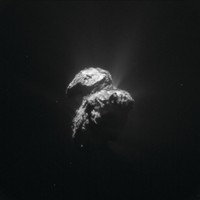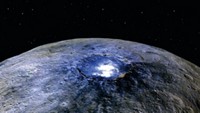Advertisement
Grab your lab coat. Let's get started
Welcome!
Welcome!
Create an account below to get 6 C&EN articles per month, receive newsletters and more - all free.
It seems this is your first time logging in online. Please enter the following information to continue.
As an ACS member you automatically get access to this site. All we need is few more details to create your reading experience.
Not you? Sign in with a different account.
Not you? Sign in with a different account.
ERROR 1
ERROR 1
ERROR 2
ERROR 2
ERROR 2
ERROR 2
ERROR 2
Password and Confirm password must match.
If you have an ACS member number, please enter it here so we can link this account to your membership. (optional)
ERROR 2
ACS values your privacy. By submitting your information, you are gaining access to C&EN and subscribing to our weekly newsletter. We use the information you provide to make your reading experience better, and we will never sell your data to third party members.
Physical Chemistry
An Icy Dust Ball in Outer Space
Lots of organics seen in first results from comet impact mission
by Elizabeth K. Wilson
September 12, 2005
| A version of this story appeared in
Volume 83, Issue 37

SPACE SCIENCE
The deep impact spacecraft sends back this report of conditions on comet Tempel 1: lots of dust, heavy on the organics.
Two months ago, after a six-month journey to Tempel 1, the National Aeronautics & Space Administration's Deep Impact vehicle released an "impactor" containing a 317-lb chunk of copper. The object slammed into the comet, spewing out a brilliant blast of debris. Images of the event were captured not only by Deep Impact but by telescopes on Earth and in space (Science, published online Sept. 8, dx.doi.org/10.1126/science.1118923).
At a press conference last week, scientists unveiled the first findings from the mission but would not speculate on what the results suggest about comets' formation and role in the solar system.
Because there's no evidence that the impactor plowed through a dusty surface into a firmer solid, it's possible that the comet is entirely made up of loose aggregates of dust, said Michael F. A'Hearn, the mission's principal investigator, at the conference.
"I'm not convinced that there is a solid layer under there," said A'Hearn, an astronomy professor at the University of Maryland. "The outer tens of meters of cometary material are unbelievably fragile. It's less strong than a snowbank."
Although the crater remains obscured by dust, scientists believe it could be as large as a football field.
The findings have implications for the European Space Agency's Rosetta spacecraft, which is carrying a lander to the comet Wirtanen. If Tempel 1 is representative of other comets, "that would mean we can't really land on the surface because [the lander] would just sink into it," said Horst Uwe Keller, of the Max Planck Institute for Solar System Research in Katlenburg-Lindau, Germany.
In addition to water and CO2, Deep Impact detected unexpectedly high levels of organic compounds after the blast. This strengthens the hypothesis that comets may have seeded the early Earth with organic molecules.
Emission spectra reveal a line that represents a C-H bond stretch that's common to a number of organic molecules, including methanol and formaldehyde. But scientists haven't yet been able to identify many of the features because of the spectra's relatively low resolution.
They have seen evidence for HCN, as well as a blend of acetylene, ammonia, and HCN. Most intriguing, though, is a strong signature of acetonitrile--stronger than what has been detected on other comets. The acetonitrile levels "are a surprise," A'Hearn remarked.
Deep Impact and some telescopes also recorded six small outbursts of debris from the comet, unrelated to the impact. The outbursts are likely generated when the sun warms patches of the comet, causing a sudden outgassing of material.





Join the conversation
Contact the reporter
Submit a Letter to the Editor for publication
Engage with us on Twitter